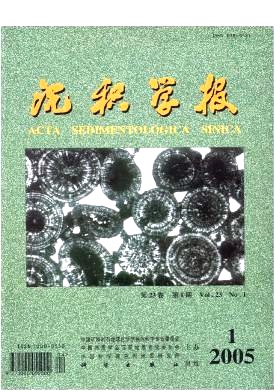HTML
| [1] | 1 刘和甫. 沉积盆地地球动力学分类及构造样式分析[J].地球科学,1993,(06):699-724. 2 刘和甫. 中国沉积盆地演化与旋回动力学环境[J].地球科学,1996,(04):345-356. 3 刘和甫,李小军,刘立群. 地球动力学与盆地层序及油气系统分析[J].现代地质,2003 (01):80-86. 4 李思田. 沉积盆地的动力学分析-盆地研究领域的主要趋向[J].地学前缘,1995,(3-4):1-8. 5 孙加鹏,张兴洲,杨宝俊. 中国东部中新生代盆地成因及其地球动力学[J].世界地质,1997,(03): 1-6. 6 冯有良,李思田,解习农. 陆相断陷盆地层序形成动力学及层序地层模式[J].地学前缘,2000,(03):119-132. 7 张渝昌. 中国含油气盆地原型分析[M].南京:南京大学出版社,1997. 1-450. 8 舒良树,周新民. 中国东南部晚中生代构造格架[J].地质论评,2002,(03):249-260. 9 舒良树,卢华复,Charvet J. 武夷山北缘断裂带运动学研究[J].高校地质学报,1997,(03): 282-292. 10 舒良树,卢华复,贾东. 华南武夷山早古生代构造事件的40Ar-39Ar同位素年代研究[J].南京大学学报(自然科学版),1999,(06):668-674. 11 邓家瑞,张志平. 赣杭构造带前寒武纪构造格局的探讨[J].铀矿地质,1997,(06):321-326. 12 邓家瑞,张志平. 赣杭构造带区域大地构造背景的探讨[J].铀矿地质,1999,(02):71-76. 13 张星蒲. 赣杭构造带中生代火山盆地的形成和演化[J].铀矿地质,1999,(01):18-23. 14 张星蒲. 赣杭构造带中生代红色碎屑沉积盆地的形成和演化[J].铀矿地质,1999,(02):77-85. 15 陈贵华,杨卫明. 中国近东西向中生代火山岩带及其铀成矿作用[J].铀矿地质,2001,(01):18-23. 16 ZhouXinmin,Li Wuxian. Origin of Late Mesozoic igneous rocks in Southeastern China: implications for lithosphere subduction and underplating of mafic magmas[J].Tectonophysics,2000, (3-4):269-287. 17 王勇,管太阳,黄国夫. 赣东北地区燕山晚期火山岩同位素年代学研究[J].地球学报,2002,(03):233-236. 18 EngeretsonDC,Cox A,Gorden R G. Relative motions between oceanic and continental plates in Pacific basin[R].Geology Society of American SpecPaper,1985.1-59. 19 GilderSA,Robert S C,Wu H R. Cretaceous and Tertiary paleomagnetic results from Southeast China and their tectonic implications [J].Earth and Planetary Sciences Letters,1993.637-652. 20 MaruyamaS,Seno T. Orogeny and relative plate motions: example of the Japanese islands[J]. Tectonophysics,1986.305-329. 21 MasayukiE. Origins and drift histories of some microcontinents distributed in the eastern margin of Asian Continent[J].Earth Science,2001,(02):71-81. 22 沈忠悦,方大钧,叶瑛. 江山-绍兴碰撞带的磁组构特征及其构造地质意义[J].Chinese Science Bulletin,1999,(10):1093-1098. 23 廖群安,李昌年,王京名. 江绍断裂带晚侏罗世S型酸性火山岩特征及其地质意义[J].地球科学,1999,(01):63-68. 24 王谦身,江为为,周文虎. 屯溪-温州地区的重力场特征和岩石圈结构与构造[A].北京:冶金工业出版社,1993.234-237. 25 俞云文,徐步台,陈江峰. 浙东南中生代晚期火山岩Nd同位素组成及其地层学意义[J].高校地质学报,2001,(01):62-69. 26 蔡正全,俞云文. 浙江白垩系上部地层的划分与对比[J].地层学杂志,2001,(04):259-266. 27 浙江省地质矿产局. 浙江省区域地质志[M].北京:地质出版社,1985.1-688. 28 田在艺,韩屏. 渤海断陷盆地拉张量分析与油气潜力[J].石油学报,1990,(02):1-12. 29 陈丕基. 晚白垩世中国东南沿海沿岸山系与中南地区的沙漠化和盐湖化[J].地层学杂志,1997,(03):203-213. 30 蔡雄飞,章泽军,张志. 赣东北白垩纪事件沉积作用[J].沉积与特提斯地质,2001,(03):71-75. 31 吴仁贵. 广丰松峰盆地的扇三角洲特征[J].江西地质,1999,(04):259-263. 32 谢爱珍. 信江盆地晚白垩世沉积体系特征与圭峰群地层划分的讨论[J].华东地质学院学报,2001,(01):5-10. 33 张志,廖群安. 江西信江白垩纪陆相盆地地质作用与构造演化[J].中国区域地质,2000,(01):38-42. 34 吕学斌. 金衢盆地沉积环境演变[J].山地研究,1993,(01):15-22. 35 陶小风,刘登忠,朱利东. 陆相盆地沉积作用与构造作用的关系[J].沉积学报,2001,(03):410-414. 36 余心起,舒良树,颜铁增. 江山-广丰地区早白垩世晚期玄武岩的岩石地球化学及其构造意义[J].地球化学,2004, (05):465-476. 37 李继亮,肖文交,闫臻. 盆山耦合与沉积作用[J].沉积学报,2003,(01): 52-60. |






 DownLoad:
DownLoad: